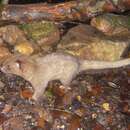en
names in breadcrumbs


This species needs to be studied in the wild, as well as in captivity, so that more information can be gathered about its life span, behavior, and reproductive habits. Also, because this species is very local in its distribution, a careful eye should be kept on its numbers.
Perception Channels: tactile ; chemical
IUCN Red List of Threatened Species: vulnerable
The golden palm civet's habit of roosting in the roof of bungalows located near the edge of the jungle may be annoying to humans, but no damage by these creatures was reported. The frugivorous habits of P. zeylonensis may be destructive if these animals live near land where fruits eaten by this species are being raised as crops (bananas, mangos, etc). However, this was not mentioned to be a large problem in any of the literature found on this species. (Phillips 1935)
As the young are easily tamed, although no detailed information was given on any tamed animals. (Phillips 1935)
The golden palm civet is mainly frugivorous, with preferences for mango, coffee, melon, pineapple and bananas. This species has also been observed to eat small mammals, birds, snakes, lizards, frogs, moths, and other insects when it is able to catch them. (Anderson 1984, Parker 1990, Phillips 1935)
Paradoxurus zeylonensis is found in south and southeast Asia, specifically in Sri Lanka and Ceylon. (Ellerman 1966, Macdonald 1985, Parker 1990)
Biogeographic Regions: palearctic (Native )
Paradoxurus zeylonensis is mainly arboreal, keeping mostly to large tree branches. They have been observed to sleep in the roof of bungalows adjacent to the jungle and in hollow tree branches. (Phillips 1935)
Other Physical Features: endothermic ; bilateral symmetry
Very little is known about the reproduction of P. zeylonensis. Young have been found in October and November, and so it is thought that reproduction occurs in the latter months of the year. It is also thought that females may have more than one litter per year. Two or three young are produced in each litter. The gestation period and life span of this species are unknown, as are the ages of weaning and sexual maturity. (Anderson 1984, Parker 1990, Phillips 1935)
Key Reproductive Features: gonochoric/gonochoristic/dioecious (sexes separate); sexual
The golden palm civet (Paradoxurus zeylonensis) is a viverrid endemic to Sri Lanka. It is listed as Vulnerable on the IUCN Red List. Its distribution is severely fragmented, and the extent and quality of its habitat in Sri Lanka's hill regions are declining.[2]
The golden palm civet was described by Peter Simon Pallas in 1778.[3]
Viverra zeylonensis was the scientific name proposed by Peter Simon Pallas in 1778 for a palm civet specimen from Sri Lanka.[3] Between the 19th and early 21st centuries, several zoological specimens were described, including:
Genetic analysis indicates that specimens of P. montanus, P. aureus and P. stenocephalus share the same haplotype. Because of their low genetic difference, they should neither be considered distinct species nor subspecies, but junior synonyms of the golden palm civet.[8]
The golden palm civet is gold to golden brown on the upper side and paler gold on the belly.[4] Individuals vary from dark sepia to ochreous, rusty or golden-brown. The tips of the contour hairs are frequently lustrous, sometimes greyish. The legs are about the same tint as the back, but the tail and the face are sometimes noticeably paler, buffy-grey. The face does not have a pattern, and the vibrissae are dirty white. The hair in front of the shoulders radiates from two whorls and grows forward along the sides of the neck and the nape to the head. It also grows forward on the fore throat, radiating from a single whorl. The dorsal pattern consists of faint bands and spots that are slightly darker than the ground colour. The lower side is slightly paler and sometimes greyer than the upper.[9] The golden palm civet has two morphs — one golden and one dark brown. Specimens from montane areas are darker, slightly greyish-toned wood-brown, and paler on the underside with a yellowish-white tail tip.[7]
The rounded ears have hairless edges. The eyes are large with vertical pupils. It emits a pleasant odour from anal glands, which is reminiscent of Michelia champaca flowers.[10]
The golden palm civet inhabits lowland rain forest, montane evergreen forests, and also dense monsoon forest.[11]
The golden palm civet is forest-dependent, yet tolerant of minor habitat modification where some continuous forest remains. It is arboreal, nocturnal, and solitary; its diet consists of fruits, berries, invertebrates, and a wide range of small vertebrates.[2]
In Sri Lanka the golden palm civet is called pani uguduwa පැනි උගුඩුවා, sapumal kalawaddha සපුමල් කලවැද්දා, or ranhothambuwa රන් හොතබුවා / hotambuwa හොතබුවා, by the Sinhala speaking community. Both golden and Asian palm civets are sometimes collectively called kalawedda in Sinhala and maranai (மரநாய்) in Tamil.[7]
However, the word hotambuwa is mostly used to refer altogether a different species, the ruddy mongoose (Herpestes smithii). Due to similar appearance and coloration, they are mistaken as the same animal.
This civet appears on the 3-rupee Sri Lankan postal stamp. However, it is labeled "Golden Palm Cat" on the stamp.
The golden palm civet (Paradoxurus zeylonensis) is a viverrid endemic to Sri Lanka. It is listed as Vulnerable on the IUCN Red List. Its distribution is severely fragmented, and the extent and quality of its habitat in Sri Lanka's hill regions are declining.
The golden palm civet was described by Peter Simon Pallas in 1778.